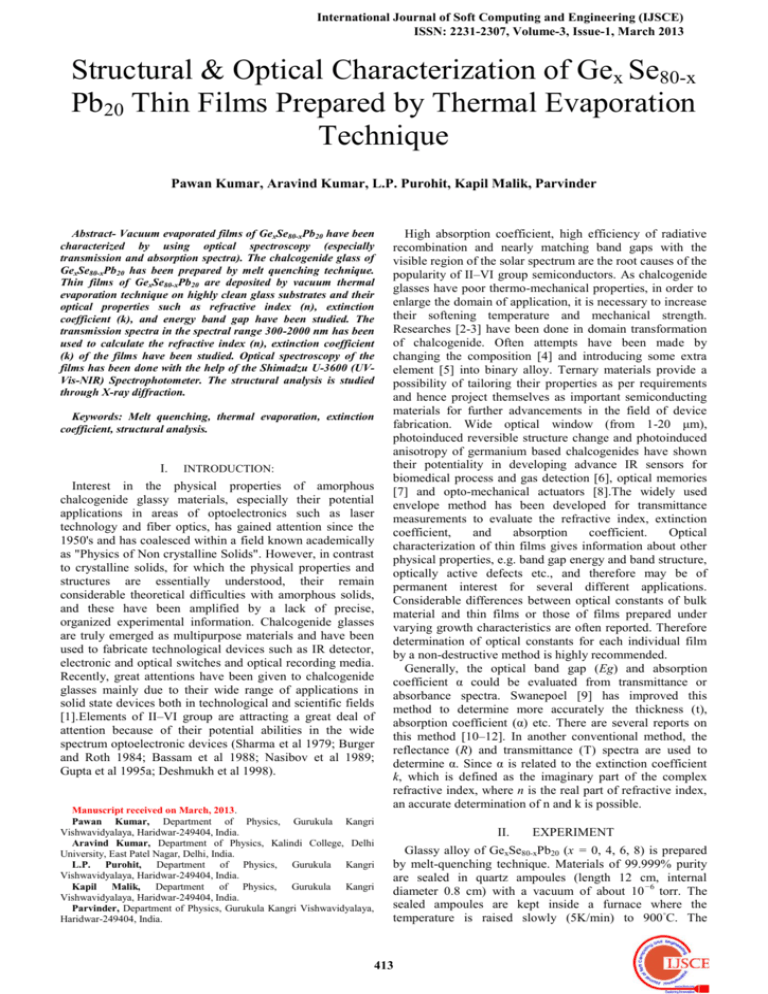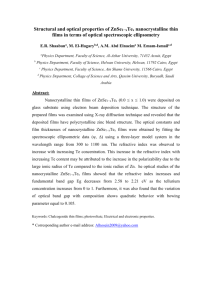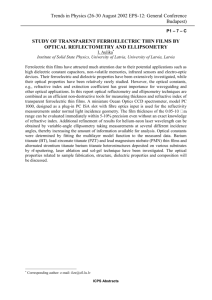Structural & Optical Characterization of Gex Se80
advertisement

International Journal of Soft Computing and Engineering (IJSCE) ISSN: 2231-2307, Volume-3, Issue-1, March 2013 Structural & Optical Characterization of Gex Se80-x Pb20 Thin Films Prepared by Thermal Evaporation Technique Pawan Kumar, Aravind Kumar, L.P. Purohit, Kapil Malik, Parvinder Abstract- Vacuum evaporated films of GexSe80-xPb20 have been characterized by using optical spectroscopy (especially transmission and absorption spectra). The chalcogenide glass of GexSe80-xPb20 has been prepared by melt quenching technique. Thin films of GexSe80-xPb20 are deposited by vacuum thermal evaporation technique on highly clean glass substrates and their optical properties such as refractive index (n), extinction coefficient (k), and energy band gap have been studied. The transmission spectra in the spectral range 300-2000 nm has been used to calculate the refractive index (n), extinction coefficient (k) of the films have been studied. Optical spectroscopy of the films has been done with the help of the Shimadzu U-3600 (UVVis-NIR) Spectrophotometer. The structural analysis is studied through X-ray diffraction. Keywords: Melt quenching, thermal evaporation, extinction coefficient, structural analysis. I. INTRODUCTION: Interest in the physical properties of amorphous chalcogenide glassy materials, especially their potential applications in areas of optoelectronics such as laser technology and fiber optics, has gained attention since the 1950's and has coalesced within a field known academically as "Physics of Non crystalline Solids". However, in contrast to crystalline solids, for which the physical properties and structures are essentially understood, their remain considerable theoretical difficulties with amorphous solids, and these have been amplified by a lack of precise, organized experimental information. Chalcogenide glasses are truly emerged as multipurpose materials and have been used to fabricate technological devices such as IR detector, electronic and optical switches and optical recording media. Recently, great attentions have been given to chalcogenide glasses mainly due to their wide range of applications in solid state devices both in technological and scientific fields [1].Elements of II–VI group are attracting a great deal of attention because of their potential abilities in the wide spectrum optoelectronic devices (Sharma et al 1979; Burger and Roth 1984; Bassam et al 1988; Nasibov et al 1989; Gupta et al 1995a; Deshmukh et al 1998). Manuscript received on March, 2013. Pawan Kumar, Department of Physics, Gurukula Kangri Vishwavidyalaya, Haridwar-249404, India. Aravind Kumar, Department of Physics, Kalindi College, Delhi University, East Patel Nagar, Delhi, India. L.P. Purohit, Department of Physics, Gurukula Kangri Vishwavidyalaya, Haridwar-249404, India. Kapil Malik, Department of Physics, Gurukula Kangri Vishwavidyalaya, Haridwar-249404, India. Parvinder, Department of Physics, Gurukula Kangri Vishwavidyalaya, Haridwar-249404, India. High absorption coefficient, high efficiency of radiative recombination and nearly matching band gaps with the visible region of the solar spectrum are the root causes of the popularity of II–VI group semiconductors. As chalcogenide glasses have poor thermo-mechanical properties, in order to enlarge the domain of application, it is necessary to increase their softening temperature and mechanical strength. Researches [2-3] have been done in domain transformation of chalcogenide. Often attempts have been made by changing the composition [4] and introducing some extra element [5] into binary alloy. Ternary materials provide a possibility of tailoring their properties as per requirements and hence project themselves as important semiconducting materials for further advancements in the field of device fabrication. Wide optical window (from 1-20 μm), photoinduced reversible structure change and photoinduced anisotropy of germanium based chalcogenides have shown their potentiality in developing advance IR sensors for biomedical process and gas detection [6], optical memories [7] and opto-mechanical actuators [8].The widely used envelope method has been developed for transmittance measurements to evaluate the refractive index, extinction coefficient, and absorption coefficient. Optical characterization of thin films gives information about other physical properties, e.g. band gap energy and band structure, optically active defects etc., and therefore may be of permanent interest for several different applications. Considerable differences between optical constants of bulk material and thin films or those of films prepared under varying growth characteristics are often reported. Therefore determination of optical constants for each individual film by a non-destructive method is highly recommended. Generally, the optical band gap (Eg) and absorption coefficient α could be evaluated from transmittance or absorbance spectra. Swanepoel [9] has improved this method to determine more accurately the thickness (t), absorption coefficient (α) etc. There are several reports on this method [10–12]. In another conventional method, the reflectance (R) and transmittance (T) spectra are used to determine α. Since α is related to the extinction coefficient k, which is defined as the imaginary part of the complex refractive index, where n is the real part of refractive index, an accurate determination of n and k is possible. II. EXPERIMENT Glassy alloy of GexSe80-xPb20 (x = 0, 4, 6, 8) is prepared by melt-quenching technique. Materials of 99.999% purity are sealed in quartz ampoules (length 12 cm, internal diameter 0.8 cm) with a vacuum of about 10 −6 torr. The sealed ampoules are kept inside a furnace where the temperature is raised slowly (5K/min) to 900 ◦C. The 413 Structural & Optical Characterization of Gex Se80-x Pb20 Thin Films Prepared by Thermal Evaporation Technique ampoules are rocked frequently for 12 h at the maximum temperature to make the melt homogeneous. After rocking, the alloys were quenched in ice water and the material was separated from the quartz ampoules. Initially, a small quantity of glassy alloy is kept in a molybdenum boat and the chamber is evacuated to a vacuum of the order of 10 -6 torr. Thin films of GexSe80-xPb20 will be prepared by vacuum evaporation technique. Well degassed corning glass plates, having predeposited aluminium/silver/copper electrode for electrical contact, will be used as a substrate for depositing amorphous/crystalline films in the planer geometry and different electrode gap. For deposition of film, highly polished and thoroughly cleaned substrates are required. First the substrates are cleaned using liquid detergent. Then it is kept in dilute nitric acid. After this, they are cleaned using distilled water and agitated ultrasonically in acetone. The evaporant materials in the glassy form are kept in the boat. The low tension (LT) supply for evaporation source is obtained from a 230V input transformer by means of parallel connections in the secondary side of the transformer. Films will be prepared at a base pressure of 10 -5 torr by keeping the substrate at room temperature. Thickness of thin films measure by using the single crystal thickness monitor. Optical measurements can also be measure in thin film by spectrophotometer. The optical spectrum was recorded at room temperature for all samples using a UVVIS-IR (UV-3600) spectrophotometer (SHIMADZU, Japan) in the wavelength range 300-2000nm. x=0 x=2 x=6 x=8 55 50 at % at % at % at % 45 Transmittance T % 40 35 30 25 20 15 10 5 0 200 400 600 800 1000 1200 1400 1600 1800 Wavelength (nm) Fig.1. Transmission spectra of GexSe80-xPb20 for different x. x=0 at % x=2 at % x=6 at % x=8 at % 6 5 Absorbance % 4 3 2 1 III. OPTICAL CHARACTERIZATION 0 The optical constants (especially refractive index and extinction coefficient) of these films have been determined from transmission spectroscopy by using Manifcier’s envelope method. The transmission and absorbance spectra for GexSe80-xPb20 have been shown in Fig.1,2 within the wavelength range 300-2000 nm. Transmission spectra of vacuum evaporated GexSe80-xPb20 films were recorded at room temperature with the help of Spectrophotometer (Shimadzu U-3600) in the wavelength range 300-2000 nm. The refractive index (n) has been determined from transmission spectra by using the formula. n = [N + (N2 + n0 2 n12)1/2]1/2 ... (1) Where n0 and n1 are the refractive index of air and substrate, respectively. The number N is given by the following equation N = [(n02+ n12)/2] + 2n0n1 [(Tmax -Tmin)/ (Tmax+ Tmin)] ------ (2) Where Tmax and Tmin are the upper extreme point and lower extreme point at a particular wavelength, respectively. The extinction coefficient (k) is given by an expression. k = (-λ/4πt) lnP ... (3) Where t is the thickness of the film and P is given by the following equation: P = C1/C2 [1-(Tmax/ Tmin)] / [1 + (Tmax / Tmin)] -- (4) Where, C1 = (n + n0) (n + n1) and C2 = (n-n0) (n1 - n) Where n is the refractive index of the films at a particular wavelength, n1 the refractive index of the substrates and n 0 is the refractive index of the air as given earlier. 200 400 600 800 1000 1200 1400 1600 1800 Wavelength (nm) Fig.2. Absorbance spectra of GexSe80-xPb20 for different x. 2.4 2.3 2.2 2.1 2 1.9 0 2 4 6 8 10 Fig.3.Refractive index (n) Vs Composition (x). 6 5 4 3 2 1 0 0 2 4 6 8 10 Fig.4. Absorption coefficient (α) Vs Composition (x). 414 International Journal of Soft Computing and Engineering (IJSCE) ISSN: 2231-2307, Volume-3, Issue-1, March 2013 It is observed that the refractive index decreases, as the concentration increased. However, the extinction coefficient increases with the increase of concentration. The optical absorption and transmission measurements will be performed on sample in the range 300-2000 nm. For determination of optical band gap Eg, the Tauc’s plot method will be used. The spectral dependence of the absorption coefficient has the form αhν = B (hν - Eg) n/2 where hν is the photon energy, eg is the optical band gap and n is a parameter depending on both the type of transition (direct or indirect) and the profile of the electron density in the valance and conduction band. The analysis of the nature of glassy alloy thin film prepared by above mention technique is done through study of X-ray diffraction pattern, by which it is found that the films are of amorphous nature as there is no significant peaks are obtained. IV. STRUCTURAL ANALYSIS XRD patterns of the as-prepared amorphous alloy of GexSe80-xPb20 (x = 0, 4, 6, 8,) thin films are presented in Fig. 5,6,7,8. There are no significant peaks observed for any of the samples. It is clear that the alloys show an amorphous nature. Fig. 8 represents a curve between intensity & angle (2θ) of Ge8Se72Pb20. V. VI. Fig. 5 represents a curve between intensity & angle (2θ) of Se80Pb20 . CONCLUSION Thin films of GexSe80-xPb20 (x = 0, 4, 6, 8) were deposited using thermal evaporation method. These films were found to be of amorphous nature as revealed from XRD result. The optical band gap (Eg ) values were determined and are found to decrease by increasing the concentration of Ge. The absorption, extinction coefficients, and refractive index were also obtained. The transmission spectra for the thin films of GexSe80-xPb20 show strong absorption at wavelength 900nm and become highly transparent at wavelength above 800 nm. No significant changes are observed in intensity of the spectra by increasing concentration of Ge. These results might be useful for development of optical disks and other semiconducting devices based on these films. ACKNOWLEDGEMENT The authors are thankful to the University Grant Commission (U.G.C.), New Delhi for financial assistance and also thankful to Department of Physics, G.K.V. Haridwar for providing experimental facilities for this work. REFERENCES 1. Fig.6 represents a curve between intensity & angle (2θ) of Ge4Se76 Pb20. N.Kushwaha, R.K. Shukla, S.Kumar, A. Kumar, Materials Letters 60 3260-3264 (2006). 2. M.M. Abd El-Raheem, H.M.Ali, ‘Crystallization kinetics determination of Pb15Ge27Se58 Chalcogenide glass by using the various heating rates (VHR) method’ Journal of Non –Crystalline Solids 356, 77-82 (2010). 3. N.A.Okereke, A.J. Ek Punobi, ‘Structural, Optical Properties and Application of Chemically Deposited Lead Selenide Thin Films’, Journal of Ovonic Research Vol.6, No.6, 277-283, (2010). 4. Archana Devasia, Santosh Kurinec, Kristy A. Campbell, and Simone Raoux ‘Influence of Sn Migration on phase transition in GeTe and Ge2Se3 thin films’ Appl. Phys. Lett. 96, 14 1908 (2010). 5. A.R.Hilton, C.E.Hones, ‘Physical Properties of Pb30-GexSe80-x Glasses’, Phys. Chem. Glasses 7, 105 (1966). 6. A. A. Wilhelm, C. Boussard-Plédel, Q. Coulombier, J. Lucas, B. Bureau, P. Lucas, Adv.Mater. 19, 3796 (2007). 7. A. V. Kolobov, P. Fons, A. I. Frenkel, A. L. Ankudinov, J. Tominaga, T. Uruga, Nat. Mater. 3, 703 (2004). 8. P. Krecmer, A. M. Moulin, R. J. Stephenson, T. Rayment, M. E. Welland, S. R. Elliott,Science 277, 1799 (1997). 9. Swanepoel R., J. Phys. E: Sci. Instrum., 16, 1214 (1983). 10. Hou Y.-Q., Zhuang D.-M., Zhang G., Zhao M., Wu m.-S., Appl. Surf. Sci., 97, 218 (2003). 11. Metin H., Esen R., J. Cryst. Growth, 141, 258 (2003). 12. Caglar M., Caglar Y., Ilican S., J. Optoelectron. Adv. Mater., 8, 1410 (2006). Fig. 7 represents a curve between intensity & angle (2θ) of Ge6Se74Pb20. 415








